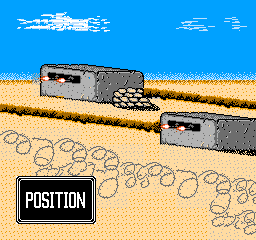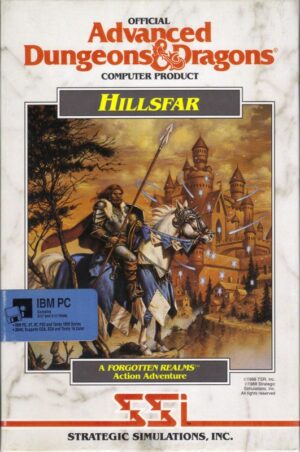Retro Replay Review
Gameplay
Desert Commander delivers a finely tuned turn-based strategy experience set against the harsh backdrop of an endless desert. Players take control of two opposing nameless armies, each relying on the tactical acumen of its commander. Over the course of five distinct campaigns, you’ll engage in a series of battles that challenge your resource management, positioning, and long-term strategy. Whether you’re facing off against the computer’s AI or dueling a friend in local multiplayer, every match feels tense and rewarding.
(HEY YOU!! We hope you enjoy! We try not to run ads. So basically, this is a very expensive hobby running this site. Please consider joining us for updates, forums, and more. Network w/ us to make some cash or friends while retro gaming, and you can win some free retro games for posting. Okay, carry on 👍)
The core loop revolves around a top-down grid battlefield where units move according to their mobility ratings and terrain restrictions. You’ll need to keep a watchful eye on ammunition and fuel gauges, refilling your squads at towns or by seizing key icons like Oases or Airfields. The variety in terrain—ranging from open dunes to rocky outcrops—forces you to adapt your tactics on the fly. A well-placed defensive line in a canyon pass can turn the tide against a numerically superior enemy.
Customization is at the heart of Desert Commander’s strategic depth. Before each match, commanders can choose two air unit types, two cannon styles, four ground vehicles, and an infantry contingent—carefully crafting a force tailored to their preferred approach. Do you emphasize rapid mechanized assaults, rely on heavy artillery bombardments, or control the skies with agile fighters? Every choice carries weight, and countering your opponent’s composition leads to thrilling “mind game” moments.
Combat itself is brought to life by animated battle sequences that play out when units clash. These skirmishes aren’t just eye candy; they emphasize the strengths and vulnerabilities of different unit pairings. Watching your tanks grind an enemy armor unit to a halt, or your attack aircraft weave through flak to strike at an exposed target, provides an immersive payoff to the planning you’ve put into each turn.
Graphics
Desert Commander’s visual presentation strikes a balance between clarity and style. The overhead maps are crisp, with distinct tile colors that denote deserts, rocky ridges, and hidden choke points. Special icons—for supply towns, oases, airstrips, and strategic positions—are immediately recognizable, allowing you to scan the battlefield at a glance and prioritize your objectives without guessing.
Unit models are rendered with enough detail to differentiate light reconnaissance vehicles from heavy tanks, and each explosion or tracer round is animated smoothly. While the aesthetic leans toward functional rather than ultra-realistic, the desert palette of golds and browns is punctuated by the bright insignias of your forces, making it easy to keep track of unit allegiance and status effects.
During clashes, the game transitions to a closer camera view, showcasing animated skirmishes that never overstay their welcome. These brief encounters highlight the firepower of different weapon systems—cannon volleys, rocket trails, strafing runs—without bogging you down in cinematic slowdowns. The user interface complements this by displaying health bars, ammo counts, and fuel gauges in a clean layout that keeps your focus on decision-making.
Overall, the graphics pipeline is optimized for speed and readability. Load times between turns are negligible, and even on mid-range hardware, the frame rate remains rock solid. For players seeking a strategy game that communicates information visually without flashy gimmicks, Desert Commander hits the mark.
Story
Though Desert Commander eschews deep character arcs or elaborate lore, it weaves its narrative through the unfolding campaigns. The nameless armies represent opposing strategic doctrines—one favoring rapid mechanized thrusts, the other relying on entrenched artillery and air support. This conceptual backdrop provides an open canvas for players to project their own epic clashes onto the desert sands.
Each of the five campaigns offers a loosely connected series of missions that escalate in complexity and challenge. Early scenarios introduce you to basic unit interactions and terrain use, while later battles throw in dynamic objectives—holding multiple outposts, surviving relentless enemy waves, or racing to capture the opponent’s Headquarters. These missions spark a sense of progression, as each victory builds toward the climactic showdown.
Though commanders remain anonymous, the stories emerge from your tactical decisions. A narrow flanking maneuver that breaks an enemy line, or a desperate air raid that saves your rear guard, become personal triumphs that form the campaign’s “narrative.” Victory conditions tied to unit preservation and map control further heighten the stakes, making every loss of a prized unit resonate like a narrative twist.
For players who crave rich backstories or character-driven plots, Desert Commander’s minimalist narrative might feel lean. However, for those drawn to emergent storytelling—where player choices and battlefield outcomes shape the tale—the game delivers a satisfying tapestry of desert warfare drama.
Overall Experience
Desert Commander stands out as a compelling strategy title that rewards patience, foresight, and adaptability. Its blend of resource management, unit customization, and dynamic battlefield conditions creates a satisfying strategic sandbox. Whether you’re plotting a methodical siege or executing lightning-fast raids, the game’s systems empower creative problem-solving and tactical ingenuity.
The inclusion of local multiplayer vs. a second player adds a welcome layer of replayability. Matches against a human opponent often highlight unforeseen synergies and counterplays, ensuring that no two games feel identical. Meanwhile, the AI presents a respectable challenge, adapting its tactics to punish predictable moves and test your ability to multitask across multiple fronts.
On the downside, the absence of online matchmaking and a deeper narrative framework may limit appeal for players seeking a fully featured campaign or competitive ladder. Additionally, some veterans of the genre may find the unit roster modest compared to grander strategy epics. Yet, these are minor quibbles in a package that excels at delivering pure, focused strategic thrills.
In conclusion, Desert Commander is a robust offering for anyone looking to dive into turn-based desert warfare. Its accessible UI, varied campaigns, and blend of mechanics make it an excellent choice for both strategy newcomers and seasoned tacticians alike. If you appreciate clear visuals, tight gameplay loops, and the satisfaction of outmaneuvering an opponent, this is one title you won’t want to leave in the sands.
 Retro Replay Retro Replay gaming reviews, news, emulation, geek stuff and more!
Retro Replay Retro Replay gaming reviews, news, emulation, geek stuff and more!









Reviews
There are no reviews yet.